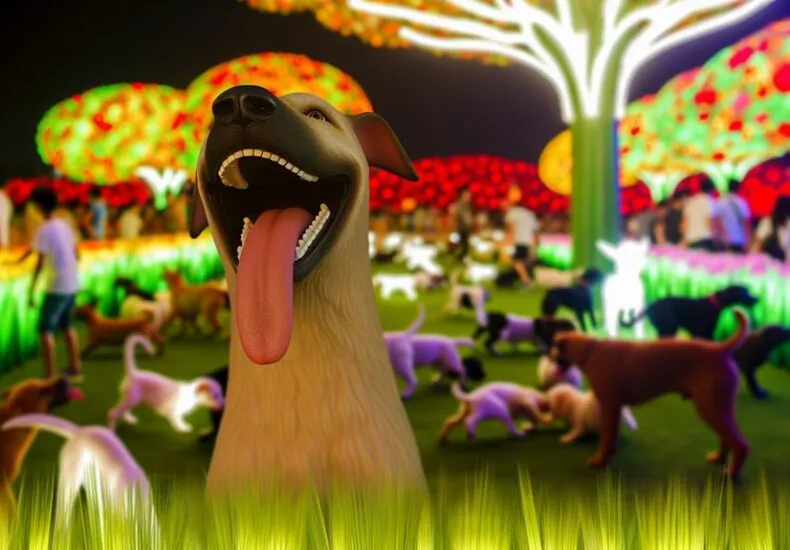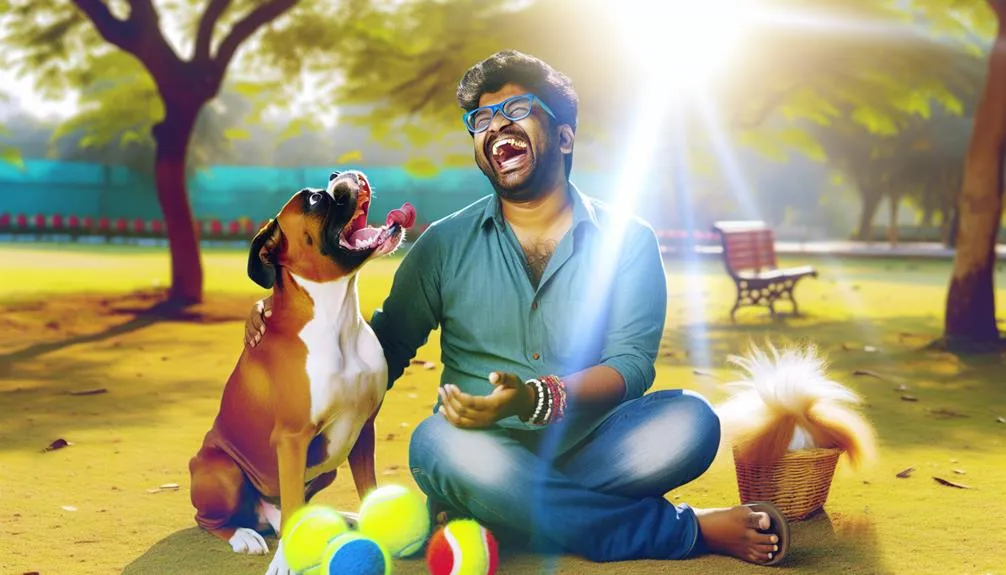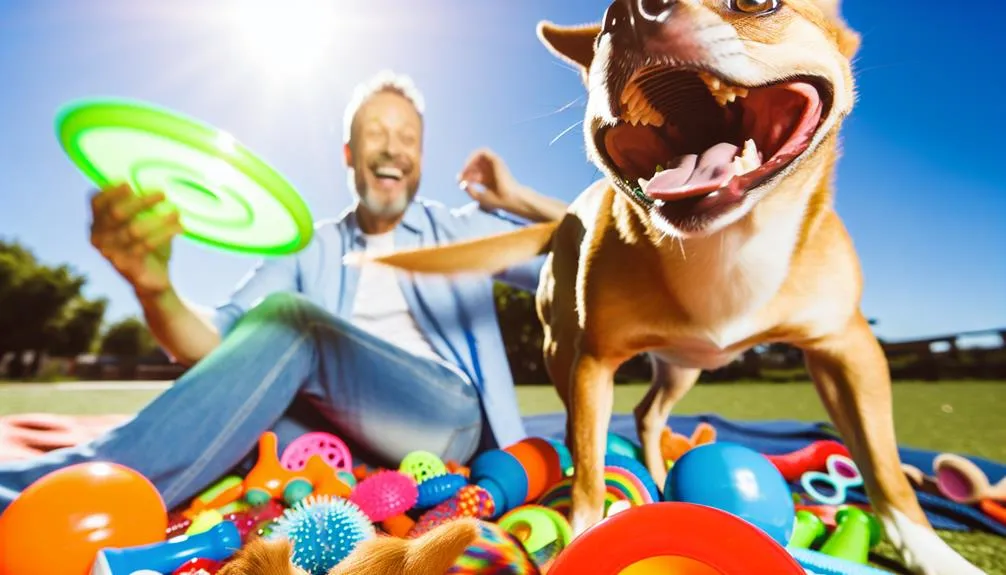
Do Dogs Laugh
You might've noticed your dog making a wheezy sound while playing fetch, a moment that seems filled with joy and excitement. This peculiar vocalization raises an intriguing question: do dogs actually laugh? While many pet owners believe their dogs express happiness through these sounds, the science behind canine laughter invites further exploration. Understanding what these sounds mean and how they relate to a dog's emotional state can deepen the bond you share with your furry friend. So, what exactly does it all signify about their feelings?
Understanding Canine Emotions
Understanding canine emotions is essential for fostering a strong bond between you and your dog. Dogs communicate their feelings through body language, vocalizations, and behaviors, which can help you identify their emotional states. Recognizing signs of canine joy—like wagging tails, playful barks, or relaxed body posture—enables you to engage more meaningfully with your pet. These expressions are not just random; they indicate a positive emotional state, signaling that your dog feels secure and happy in your presence.
By paying attention to your dog's emotional signals, you can enhance emotional bonding. For instance, when you respond to your dog's playfulness with enthusiasm, you're reinforcing that joyful connection. This reciprocal interaction leads to a deeper understanding of each other's emotions. It's vital to remember that dogs also experience negative feelings like anxiety or fear. Acknowledging these emotions requires a careful approach; you may need to adjust your behavior to provide comfort and reassurance.
Moreover, a dog's emotional well-being is tied to their overall health. Stress or distress can manifest in various behaviors, impacting their ability to bond with you. Creating a stable environment where your dog feels loved and safe promotes their emotional health and strengthens your relationship.
In essence, embracing the full spectrum of canine emotions not only enriches your dog's life but also enhances your mutual understanding, leading to a lasting emotional bond that benefits both of you.
The Science of Dog Laughter
When you observe your dog during playful moments, you might notice specific vocalizations and body language that suggest they're expressing joy. Comprehending these forms of canine communication can provide insight into their emotional states and strengthen your bond. Recent research into dog emotions reveals fascinating connections between their behavior and what we interpret as laughter, inviting us to reconsider how we perceive their happiness.
Understanding Canine Communication
Canine communication is a fascinating domain that often goes unnoticed, yet it plays a crucial role in how dogs express their emotions and interact with humans and each other. Understanding this communication helps you appreciate the nuances of canine playfulness, which is essential for fostering emotional bonding between you and your dog.
Dogs exhibit various behaviors to convey feelings, from playful barks to wagging tails, each representing different emotional states. When your dog engages in play, it's not just about fun; it's also a significant aspect of their social development. This playfulness helps them form connections with other dogs and reinforces their bond with you.
You might notice your dog's body language during these moments—ears perked, tail wagging, and a relaxed stance. These signals indicate joy and the desire for interaction. By recognizing these behaviors, you can respond appropriately, strengthening your relationship.
In essence, understanding canine communication enriches your experience with dogs, allowing you to respond to their needs and emotions better. This understanding fosters deeper emotional bonding, making your relationship with your furry friend even more rewarding.
Vocalizations and Body Language
The concept of laughter in dogs, often referred to as "dog laughter," is an enchanting area of study that intertwines vocalizations and body language. When you observe your dog, you might notice how their playful barking and joyful howling accompany moments of excitement and interaction. These sounds may serve as a form of communication, indicating happiness or a playful mood.
To better understand this phenomenon, consider these key aspects of canine vocalizations and body language:
- Playful barking often occurs during games, signaling enthusiasm and a desire to engage.
- Joyful howling can emerge in response to music or other dogs, demonstrating social bonding.
- Body posture, such as a wagging tail or relaxed ears, amplifies their vocal expressions, indicating a friendly demeanor.
- Facial expressions—like a relaxed mouth or wide eyes—can further enhance the perception of joy.
Research on Dog Emotions
Understanding dog laughter requires a closer look at the emotional lives of dogs, as research increasingly reveals the depth of their feelings. Studies show that dogs exhibit various happiness indicators, such as wagging tails and relaxed body postures, which signal their emotional intelligence. These expressions of canine joy often emerge during playful behavior, reinforcing social bonding between dogs and their human companions.
Research highlights that joyful interactions can lead to significant stress relief for both you and your dog. When you engage in play, your dog not only experiences happiness but also displays emotional expressions that deepen your connection. Additionally, dogs demonstrate remarkable canine empathy, responding to your emotions and mirroring your feelings. This emotional resonance enhances their overall well-being.
As you observe your dog's behavior, consider how their laughter-like vocalizations are intertwined with their emotional landscape. Understanding this connection provides insight into their capacity for joy and reinforces the importance of nurturing their emotional needs. Ultimately, recognizing the complexity of dog emotions can enrich your relationship and lead to a more fulfilling companionship, where laughter and love coexist harmoniously.
Sounds Dogs Make When Happy

When a dog is genuinely happy, it often expresses that joy through a variety of distinct sounds. These vocalizations are not just random noises; they serve as a communication tool, indicating to you and other canines that they're feeling good. By recognizing these sounds, you can better understand your dog's emotional state.
Here are some common sounds that signify happiness in dogs:
- Happy barks: Short, quick barks often indicate excitement or playfulness.
- Joyful whines: A soft whine can express enthusiasm, particularly when your dog anticipates fun activities like walks or playtime.
- Playful yips: These high-pitched sounds are typically made during play and signal that your dog is having a great time.
- Contented sighs: A deep, relaxed sigh can indicate satisfaction, especially after a good meal or a long cuddle session.
Accompanying these sounds are physical cues like enthusiastic tail wags and prancing steps, enhancing the overall picture of a happy dog. Excited growls may also emerge during play, indicating your dog is engaged and enjoying themselves. Cheerful howls can be heard during moments of exuberant excitement or when your dog is trying to join in on the fun. Recognizing these vocalizations allows you to connect with your dog on a deeper level, fostering a more enriched relationship. By paying attention to these sounds, you're not just observing; you're actively engaging in your dog's emotional world.
Behavioral Signs of Joy
Recognizing vocalizations is just one part of understanding a dog's emotional landscape; their body language and behaviors also provide significant insights into their joy. One of the most common indicators is tail wagging. When a dog wags its tail vigorously, especially in a wide arc, it often signifies happiness. This movement can be accompanied by playful barks, which further express their enthusiasm.
Joyful leaps—where your dog springs into the air with excitement—are also a clear sign of a happy pooch. You might notice happy whines accompanying these bursts of energy, indicating readiness, particularly when they anticipate social play with you or other dogs. Additionally, excited spins are another telltale sign; if your dog spins around in circles, they're likely overwhelmed with joy.
A relaxed demeanor can also highlight a dog's contentment. When they lie down with their belly exposed, or when they roll onto their back, it indicates trust and relaxation, fundamental elements of joy. During interactions, you may also notice affectionate nudges; these gentle pushes are a dog's way of seeking attention and reinforcing their bond with you.
Understanding these behaviors creates a clearer picture of a dog's emotional state. By observing tail wagging, playful barks, joyful leaps, happy whines, excited spins, a relaxed demeanor, social play, and affectionate nudges, you can better appreciate the depth of joy in your canine companion's life.
Comparing Canine and Human Laughter

While laughter is often viewed as a uniquely human trait, recent research suggests that dogs may have their own version of this joyful expression. Canine humor, though different from human laughter, plays a crucial role in their social interactions and emotional well-being. Just like you might share a laugh with friends, your dog may express joy through specific vocalizations and body language.
Here's how canine laughter compares to human laughter:
- Vocalization: Dogs produce a unique "laughing" sound, often resembling a wheezy exhale, which signals playfulness.
- Body Language: A playful stance, wagging tail, and relaxed ears often accompany their laughter, indicating a happy mood.
- Social Bonding: Just as laughter strengthens human relationships, dogs use their version to bond with their human companions and fellow canines.
- Stress Relief: Both humans and dogs experience laughter benefits, including reduced stress and increased feelings of happiness.
Understanding this comparison can deepen your connection with your furry friend. By recognizing their laughter, you can engage in activities that promote joy and playfulness, fostering a stronger bond. It's important to appreciate that while their expressions of humor might not be the same as ours, they enrich their lives and ours in meaningful ways. So, the next time you hear that quirky sound, remember it's your dog's way of sharing happiness with you!
Expert Opinions on Dog Laughter
Experts in animal behavior and communication have increasingly focused on understanding the nuances of dog laughter, particularly in relation to their social interactions. They've identified specific laughter triggers, which often stem from moments of canine playfulness. When dogs engage in activities that foster emotional bonding—like chasing each other or playful wrestling—they often emit unique vocalizations that resemble laughter. These sounds can function as joy expressions, signaling their happiness and enjoyment during these interactions.
Research suggests that these laughter-like sounds serve as significant happiness indicators among dogs. They not only enhance social interactions with other dogs but also strengthen your bond with them. When your dog playfully barks or emits a "huffing" sound, it's a sign of their vocal playfulness, indicating that they're in a state of joy and comfort. This behavior is crucial for their emotional well-being and social development.
Furthermore, experts emphasize that understanding these laughter-like vocalizations is essential for interpreting dog behavior. Recognizing when a dog is truly happy versus when it's anxious or stressed can help you respond appropriately. In this way, being attuned to these laughter triggers can improve your relationship with your dog, fostering an environment where both of you thrive emotionally. By appreciating their unique expressions of joy, you not only enhance your understanding of canine behavior but also contribute to a deeper emotional connection with your furry companion.
Encouraging Laughter in Dogs

To encourage laughter in dogs, you can engage in playful interactions that stimulate their natural instincts and promote joy. Incorporating positive reinforcement strategies, such as treats or praise during these moments, can enhance their playful behavior. Understanding and responding to your dog's unique preferences will help foster an environment where laughter can thrive.
Playful Interaction Techniques
Many dog owners might be surprised to learn that their pets can exhibit behaviors resembling laughter during playful interactions. Engaging your dog in various activities not only stimulates their mind but also encourages these joyful expressions. Techniques that promote laughter often involve social play and physical engagement. Here are some effective playful interaction techniques:
- Fetch games: Tossing a ball or toy can invoke excitement, leading to playful barks and energetic leaps.
- Play bows: Encourage your dog to engage in play bows, signaling their enthusiasm to interact.
- Interactive puzzles: Stimulate their problem-solving skills, fostering a sense of accomplishment and joy.
- Chase activities: Engage in games of chase, where both you and your dog can experience bursts of energy and laughter.
Incorporating these activities—like tug toys, agility drills, scent games, hide and seek, and even water play—can enhance your bond and create a joyful atmosphere. Observing your dog's reactions during these interactions can deepen your understanding of their emotional states, allowing for a richer and more fulfilling connection. So, get ready to laugh along with your canine companion!
Positive Reinforcement Strategies
Positive reinforcement strategies can play an essential role in encouraging laughter and joyful behaviors in dogs. When you use treat rewards during training sessions, you can create positive associations that lead to happiness and enthusiasm. Dogs respond well to these rewards, and the anticipation of receiving a treat can spark playful behaviors that resemble laughter.
Incorporating training games into your routine is another effective approach. Games like fetch or hide-and-seek promote engagement, fostering a sense of excitement. This playful bonding not only enhances your relationship but can also elicit those joyful responses you're hoping to see.
Don't underestimate the power of positive praise. Verbal affirmations and affectionate gestures reinforce the idea that your dog is doing something right, further motivating them to express their joy.
As you combine these strategies, be mindful of your dog's unique personality and preferences. Tailoring your approach allows for a more engaging experience, enhancing the chance of eliciting those delightful, laughter-like sounds. Ultimately, the goal is to create a joyful environment where your dog feels comfortable expressing itself, strengthening your bond through positive reinforcement.
Frequently Asked Questions
Can All Dog Breeds Laugh or Just Certain Ones?
Dog breed differences can influence laughter behavior. While some breeds may display more playful expressions resembling laughter, not all dogs exhibit this trait. It's crucial to observe individual personalities rather than generalizing across breeds.
Do Puppies Laugh Differently Than Adult Dogs?
You'll find puppies exude playful energy, their laughter bubbling like a brook, while adult dogs might chuckle with more restraint, reflecting their seasoned demeanor. This difference showcases how age shapes expression and communication in our furry friends.
Is Dog Laughter Contagious Among Other Dogs?
In dog interactions, laughter responses can indeed be contagious. When one dog exhibits playful vocalizations, others often join in, creating a joyful atmosphere that enhances their social bonding and promotes overall well-being within their group.
Can Dogs Recognize Human Laughter?
You might be surprised, but dogs can recognize human laughter. Their emotional intelligence allows them to respond to laughter, often mirroring your laughter response, showcasing a deep connection and understanding of human emotions.
How Can I Tell if My Dog Is Happy Without Laughter?
You can tell your dog's happy by observing their body language. Look for tail wagging, playful barking, relaxed posture, direct eye contact, and happy panting. These signs indicate your pup's contentment and joy in interacting with you.
Conclusion
To sum up, recognizing that dogs can indeed express joy through laughter-like sounds deepens our understanding of their emotions. As the saying goes, "laughter is the best medicine," and this holds true for our canine companions. By fostering playful interactions that elicit these joyful vocalizations, you not only enhance your dog's well-being but also strengthen your bond. Embracing their unique forms of laughter enriches the relationship, ensuring both you and your furry friend thrive together in happiness.
You may also like
Archives
Calendar
| M | T | W | T | F | S | S |
|---|---|---|---|---|---|---|
| 1 | 2 | 3 | 4 | 5 | 6 | |
| 7 | 8 | 9 | 10 | 11 | 12 | 13 |
| 14 | 15 | 16 | 17 | 18 | 19 | 20 |
| 21 | 22 | 23 | 24 | 25 | 26 | 27 |
| 28 | 29 | 30 | ||||
Leave a Reply